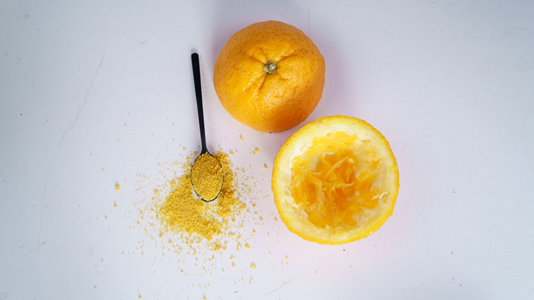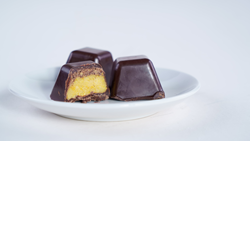Orange peels are the residual flows of juice production. How many supermarkets, cafes, restaurants and other catering establishments do you know that sell fresh orange juice? Often nothing is done with the peels. Every year, 10,000 trucks with orange peels are thrown away in the Netherlands. BonBorange wanted to use this residual flow as optimally as possible and that is why they processed it into a bonbon.
Orange peels contain valuable substances, such as vitamin C, oils, fibers and pectins! The peel has two parts, the orange part and the white part. The orange part turns into a powder that has a fresh orange flavor.
Pectin is extracted from the white part, which we use to make a jelly. We fill our bonbon with these two great ingredients.
Bonborange stood for enjoyment and bringing together sustainability. Even if you enjoy a delicious bonbon, you can do something good for the environment!
---
After five wonderful years, the founders decided to stop Bonborange in April 2025.
"This was not an easy choice, because we have worked on our company with a lot of fun and enthusiasm. However, it is time to pursue our personal ambitions and that makes it difficult to continue Bonborange in this way.
We look back on a great experience in which we not only learned a lot about entrepreneurship, but also built a valuable network within the food and sustainability sector and were able to talk and work with many inspiring people.
Our journey had many highlights, such as:
* Winning the Wij Inholland Award 2020
* 3rd prize regional pitch battles Jong Ondernemen
* Reaching the semi-finals of The Best Student Company of the Year 2020 by Jong Ondernemen
* Winning the encouragement prize of DutchFoodWeek
* TV Debut on NH Nieuws
* Finalist The Hague Innovators challenge organized by Impact city
* Being a guest on the radio at Den Haag FM
* Introducing many tasty products: Bonborange bonbon, luxury filled chocolate letter, orange flips, Christmas wreaths and Easter eggs.
But it was going so well?
”Yes, it was going well. Bonborange was growing: We gained more brand awareness, developed better products and worked together with inspiring partners. At the same time, we also saw the challenges increase. The price of cocoa kept rising and we noticed that we personally could not free up enough time and space to let Bonborange grow sustainably."


The pectin from the white part of the orange peel is used to make a jelly. The jelly is enriched with the powdered orange part of the peel. Together they form a tasty filling for bonbons.
The startup BonBorange is looking for resalers who, besides selling the products, also wants to tell the story of these bonbons to the consumer.
The startup BonBorange wants to grow and is therefore looking for a producer that can produce jelly from the peels.
White pulp from the skin remains from our process. This can be further utilised, on a larger scale, e.g. in the paper industry.